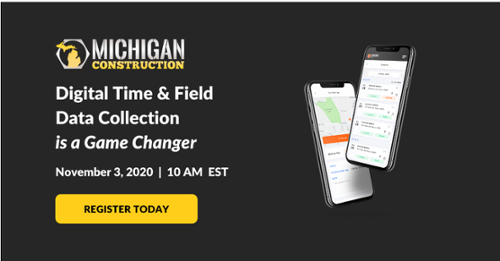
Most construction firms still struggle with tracking and using field data required to operate the business. You rely on paper forms and spreadsheets to track workers, jobs, and equipment. Other data comes in through word of mouth. You stick with these methods because they’re familiar..
But, for most firms, these manual processes are just barely working to get the job done. Over time, they break down and hurt the bottom line.
While many construction leaders realize they’re not operating as efficiently as they can, adopting new technology and automated processes seems risky.
What’s the opportunity of digital tools? Where do you even start a project?
Why Adopt Technology Now
For years, construction has lagged in technology adoption. However, the industry is now at an inflection point. 29% of small and mid-sized trade contractors are investing in software to automate business processes. Owners and managers need to keep projects safe, on time, and under budget.
80% of construction companies can’t find the workers they need. Labor shortages for the past several years are causing increased timelines and costs on projects, affecting profitability and the ability to compete. And, COVID-19 is making the need to monitor real time field data more important than ever.
Your workforce is also changing. The next generation is already on your job sites and they grew up using technology. They’re ready for faster processes that leverage mobile devices and real time data input.
Lastly, the right technology is now accessible. Smartphones are in (just about) everyone’s pockets and 5G network access has already arrived at your job sites (or will be arriving soon).
However, software from 10 to 15 years ago doesn’t adapt well for today’s world of mobile and real time data. These solutions tend to be “one size fits all,” which is problematic in an industry where no two projects are the same.
Today, there’s flexible and semi-custom software that’s both innovative and practical for the problems you’re trying to solve. There are mobile apps, dashboards, and system integrations to:
- Instantly sync worker/crew time for payroll
- Capture T & M on the fly
- Collect real time photos and updates on job progress
- Automate data reporting and alerts
- Integrate accounting systems with field data
The pandemic has increased the urgency to innovate and created an opportunity for firms (of any size) to capitalize on changing behaviors. Companies who still operate on paper, whiteboards, or Excel risk getting left behind.
Want to see these best practices in action? Join our free webinar November 3rd at 9:00a: Digital Time and Field Data Collection is a Game Changer [REGISTER NOW]
Automating Your Biggest Process Pains
To uncover the low-hanging fruit for digital automation, start with a few simple questions:
- What processes should we streamline?
- What important data could we be capturing with an easier workflow?
- What will motivate my team to use a new tool?
- What opportunities and pitfalls will a new process reveal?
It helps to first look for repetitive and inefficient employee tasks like:
- Writing out forms for Time Entry, T & M, Safety, Dailies, etc
- Managing scheduling changes and issues
- Manually transferring data from one system to another
- Piecing together costing and job reports
How can you eliminate double data entry? What are the biggest bottlenecks? What’s the most time consuming?
Aligning Stakeholders
As you’re outlining your processes to automate, it’s important to get buy-in from key users in each department. Ask for their input on what changes would make the biggest impact on their work.
Listen for examples that will equate to measurable time savings, better collaboration, and more accountability through data.
If you’re not sure where to start, read this quick article about how to gather your team’s input that includes a free worksheet.
Start Small, Big Impact
At first, you might be tempted to try to change everything at once.
But, this could lead you to a messy and frustrating software project, especially if you’re implementing digital tools for the first time.
Instead, we recommend you start small. Identify the processes that will have the biggest impact on your business and prioritize them first. This ensures you get a faster return on your investment and that you undertake a project that your team can handle.
Just remember that digital transformations don’t happen overnight. Focus on incremental improvements over the long run.
Choosing the Right Technology Partner
Most small and medium sized trade contractors don’t have in-house software developers. This means you’ll need to find a tech firm that will understand your workflow and existing systems.
Picking the right partner is crucial to the project’s success. You want to work with someone you’re comfortable collaborating with and who aligns the development process with your business goals.
When evaluating tech firms who specialize in construction, use these 5 strategic questions to see if they’re the right partner for the job.
Calculating ROI
Next, we’ll cover how to calculate the ROI for mobile field technology.
It’s great to have an idea of where to start, but you’ll want to make sure you have a true business case for investing in innovation!

